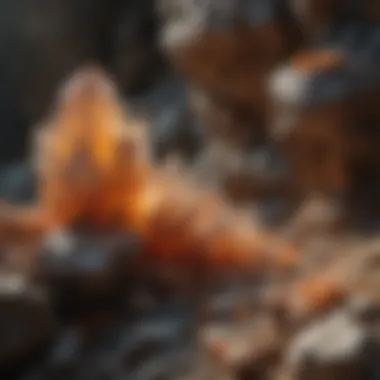Unraveling the Enigmatic Bond: A Journey into Mineral Mysteries Within Rocks


Rock and Mineral Identification
In the realm of rocks and minerals, identifying various types plays a pivotal role in understanding their composition and geological significance. Rocks can be broadly categorized into igneous, sedimentary, and metamorphic, each possessing distinct characteristics that aid in identification. Igneous rocks, formed from volcanic activity, exhibit a crystalline structure with minerals like quartz and feldspar. On the other hand, sedimentary rocks, such as limestone and sandstone, showcase layers indicating their formation from sediment deposits. Metamorphic rocks, like marble and slate, display unique textures due to intense heat and pressure. Fossil identification involves recognizing organic remains preserved in rocks, varying from imprints to actual remains. Tools like geologist hammers, magnifying glasses, and mineral hardness kits are essential for accurate identification, allowing enthusiasts to delve deeper into the mysteries of rocks and minerals.
Mineral Composition and Geological Significance
Exploring the composition of minerals within rocks unveils a plethora of chemical elements intricately bonded to form crystalline structures. Minerals like quartz, feldspar, and mica represent the building blocks of rocks, each with unique properties contributing to their overall appearance and hardness. Geological formations, shaped over millions of years through tectonic movements and natural processes, provide a historical narrative of Earth's evolution. Rocks and minerals serve as geological archives, offering insights into past environments and climatic conditions. By studying their composition and distribution, geologists can unravel the mysteries of Earth's subsurface, identifying mineral deposits and understanding the forces that shape our planet.
Introduction
In this intricate exploration, we delve into the enigmatic world of minerals concealed within rocks. The article aims to unveil the profound connection between minerals and rocks, shedding light on their composition, significance, and the profound impact they have on geological formations. By navigating through the formation processes and identification techniques, we aim to offer a comprehensive guide that uncovers the hidden treasures lying beneath the Earth's surface.
Exploring the Hidden World
The Fascination with Rocks
The intriguing allure of rocks lies not only in their physical presence but in the stories they silently narrate about Earth's history. Rocks serve as cryptic time capsules, holding within them a chronicle of geological events and processes that have sculpted our planet over millions of years. Their stoic nature fascinates geologists and lay enthusiasts alike, beckoning them to decipher the enigmatic narratives etched upon their rugged surfaces. The fascination with rocks offers a gateway to understanding Earth's evolution and the intricate interplay between minerals and geological phenomena. Despite their outwardly silent demeanor, rocks speak volumes about the tumultuous journey of our planet, making them indispensable elements in deciphering the Earth's geological history.
The Diversity of Minerals
Complementing the enduring charm of rocks is the unparalleled diversity of minerals nestled within them. Minerals serve as the building blocks of rocks, imparting them with unique textures, colors, and properties. The vast spectrum of minerals encompasses a myriad of chemical compositions and crystalline structures, each bearing its distinct characteristics and significance in geological processes. From the vibrant hues of gemstones to the subtle sheen of metallic ores, minerals showcase nature's artistic prowess and the intricate beauty that lies beneath the Earth's crust. Exploring the diversity of minerals unveils a kaleidoscopic world of geological treasures, each mineral enriching the tapestry of Earth's lithosphere with its individuality and essence.
Importance of Minerals in Rocks
Structural Significance
The role of minerals in rock formation extends beyond mere aesthetics, delving into the fundamental aspect of structural integrity. Minerals act as the binding agents that cement individual grains of rock together, creating robust geological formations that withstand the test of time. The structural significance of minerals lies in their ability to dictate the strength, durability, and overall stability of rocks, shaping landscapes and landforms through their diverse compositions. By understanding the structural significance of minerals, geologists unravel the intricate mechanisms that govern rock behavior, offering insights into the geological forces that have shaped our planet over millennia.
Geological Processes
At the heart of Earth's dynamic processes lies the indispensable role of minerals in driving geological transformations. Minerals serve as the catalysts that initiate and support various geological reactions, influencing the formation of rocks through intricate chemical interactions. From the crystallization of igneous rocks to the compaction of sedimentary layers, minerals play a pivotal role in shaping Earth's crust and lithosphere. The study of geological processes sheds light on the intimate relationship between minerals and rocks, unraveling the mysterious forces that have shaped landscapes, mountains, and continents over geological timescales.


Understanding Mineral Formation
In the realm of geological studies, understanding how minerals form within rocks plays a pivotal role in unraveling the mysteries hidden beneath the Earth's surface. The process of mineral formation, encompassing igneous, sedimentary, and metamorphic rock formations, sheds light on the intricate mechanisms that shape our planet's geological landscapes. By scrutinizing the genesis of minerals within rocks, geologists can decipher the environmental conditions, timescales, and geological events that have transpired over millennia, contributing to a deeper comprehension of Earth's dynamic history.
Intricate Processes Unveiled
Igneous Rock Formation
Delving into the domain of igneous rock formation reveals a fascinating journey of molten magma solidifying into rock. This process, characterized by the cooling and crystallization of magma, unfolds beneath the Earth's crust, forming igneous rocks such as granite and basalt. Ignis, the Latin word for fire, encapsulates the fiery origins of these rocks, showcasing the intense heat and pressures involved in their creation. The key allure of igneous rocks lies in their pristine mineral compositions and crystalline structures, offering valuable insights into the planet's volcanic activities and magmatic evolution.
Sedimentary Rock Formation
The sedimentary rock formation represents a distinct tableau of geological processes, where sediments accumulate and undergo lithification to form rocks like sandstone and limestone. Through deposition, compaction, and cementation, sedimentary rocks preserve a mosaic of earthly materials, revealing clues about ancient environments and depositional settings. Their stratified nature tells tales of past landscapes and climates, painting a vivid picture of Earth's historical narratives embedded within their layers.
Metamorphic Rock Formation
Traversing the intricate pathways of metamorphic rock formation unveils a metamorphic dance of pressure, temperature, and recrystallization. As existing rocks undergo profound transformations due to tectonic forces or thermal influences, metamorphic rocks such as marble and schist emerge as testaments to the Earth's dynamic forces. The allure of metamorphic rocks lies in their ability to showcase the vast spectrum of mineral changes and structural reconfigurations, offering glimpses into the profound geological upheavals that have shaped our planet.
Factors Influencing Mineral Composition
Temperature and Pressure
The interplay of temperature and pressure stands as a fundamental influence on mineral composition within rocks, governing the crystalline arrangements and stability of mineral assemblages. Variations in temperature and pressure conditions can catalyze mineral transformations and induce metamorphic processes that alter rock compositions. This dynamic relationship between temperature and pressure serves as a cornerstone in understanding the diverse mineralogical landscapes shaping our planet's geology.
Chemical Reactions
Chemical reactions wield a significant impact on mineral composition, driving the formation and alteration of minerals within rocks. Through chemical exchanges and reactions with surrounding fluids or rock materials, minerals can undergo metamorphic changes or precipitate from solutions to form crystalline structures. The intricate dance of chemical reactions within rocks unveils a tapestry of mineralogical diversity, highlighting the dynamic interplay between Earth's chemical reservoirs and geological formations.
Identifying Minerals in Rocks
Identifying minerals in rocks plays a pivotal role in comprehending the geological landscape of our planet. By scrutinizing the composition of rocks, geologists can decipher crucial information about Earth's history, tectonic movements, and environmental changes. The process involves precise analytical techniques that reveal the hidden constituents within rocks. These methods are imperative for understanding the structural formations and mineral diversity present in rocks, offering profound insights into the Earth's subterranean realm.


Analytical Techniques
X-Ray Diffraction
In the realm of identifying minerals in rocks, X-Ray Diffraction emerges as a paramount analytical technique. This method enables scientists to discern the crystalline structure of minerals by analyzing how X-rays interact with the atomic arrangement within a sample. The key characteristic of X-Ray Diffraction lies in its unparalleled ability to identify minerals based on their crystal lattice structure, providing precise information about mineral composition and species. Its distinction in this article stems from its efficacy in revealing mineral polymorphs and distinguishing between mineral phases, essential for unveiling the complex mineralogy existing in rocks. While X-Ray Diffraction offers exceptional accuracy in mineral identification, some limitations include the requirement of crystalline samples and potential challenges in analyzing certain minerals with similar structures.
Spectroscopy Methods
Among the analytical techniques employed in identifying minerals in rocks, Spectroscopy Methods stand out for their spectral analysis capabilities. By measuring the interaction between minerals and electromagnetic radiation, spectroscopy techniques such as infrared and Raman spectroscopy unveil distinctive chemical compositions and molecular vibrations present in minerals. The uniqueness of Spectroscopy Methods lies in their non-destructive nature and ability to provide rapid mineral identification based on spectral fingerprints. Their relevance in this article lies in their efficiency in characterizing mineral assemblages and detecting mineral alterations caused by geological processes. While offering quick and reliable mineral identification, Spectroscopy Methods may face challenges in resolving complex mineral mixtures and require calibration for precise mineral quantification.
Microscopy
In the realm of identifying minerals in rocks, Microscopy serves as an indispensable analytical tool for scrutinizing mineral textures and morphology. By utilizing light microscopy or electron microscopy, geologists can examine the physical characteristics of minerals such as crystal habit, cleavage, and color under magnification. The significance of Microscopy in this article stems from its capability to differentiate minerals based on their optical properties and crystal structures, aiding in accurate mineral identification and classification. The advantages of Microscopy lie in its high-resolution imaging and ability to visualize minute mineral details, crucial for determining mineral associations and petrographic relationships within rocks. However, the limitations of Microscopy include the time-intensive sample preparation processes and potential challenges in differentiating minerals with similar optical properties.
Diagnostic Properties
Hardness Scale
The Hardness Scale serves as a fundamental diagnostic property in identifying minerals in rocks, offering insights into the physical resistance of minerals to abrasion and scratching. Based on Friedrich Mohs' scale of hardness ranging from 1 (talc) to 10 (diamond), this property aids geologists in distinguishing minerals through simple scratch tests or hardness comparisons. The key characteristic of the Hardness Scale lies in its user-friendly and practical application for rapid mineral identification, enabling quick differentiation between soft and hard minerals based on their hardness values. In the context of this article, the significance of the Hardness Scale lies in its straightforward method of mineral discrimination and correlation with mineral formation environments. While providing a valuable qualitative assessment of mineral hardness, the Hardness Scale may present challenges in accurately categorizing minerals with similar hardness values.
Luster and Color
The diagnostic properties of luster and color play a crucial role in identifying minerals in rocks by offering visual clues about mineral characteristics. Luster refers to the appearance of a mineral's surface under reflected light, ranging from metallic to non-metallic categories such as vitreous, pearly, or dull. On the other hand, color denotes the hue of a mineral caused by its chemical composition or impurities. The key characteristic of luster and color lies in their observational utility for quick mineral identification, providing initial insights into mineral types and compositions. In the context of this article, luster and color serve as essential diagnostic properties for preliminary mineral discrimination and can aid geologists in identifying minerals before conducting detailed analyses. Despite their effectiveness in visual mineral identification, luster and color assessments may encounter challenges in distinguishing between minerals with similar visual appearances and variations caused by surface treatments or weathering effects.
Significance of Mineral Diversity
Minerals play a pivotal role in shaping geological formations and processes, making their diversity a crucial aspect to study. Understanding the variety of minerals present in rocks provides insight into the Earth's history and composition. By examining different mineral compositions, scientists can decipher the environmental conditions under which rocks formed, helping to reconstruct past landscapes and ecosystems. The significance of mineral diversity lies in its ability to act as a geological archive, offering a glimpse into the intricate interplay of elements that have shaped our planet over millions of years.
Impact on Geological Processes
Tectonic Movements


Tectonic movements, such as plate collisions and subductions, are fundamental geological processes that are heavily influenced by mineral composition. The minerals present in rocks dictate their strength, ductility, and response to stress, thus impacting the way tectonic plates interact. Understanding the role of minerals in tectonic movements is essential for predicting seismic activities, mountain building, and the formation of natural resources. While the complex nature of tectonic movements poses challenges in precise predictions, studying mineral diversity can provide essential clues to mitigate geological hazards and optimize resource exploration.
Volcanic Activity
Volcanic activity is another geological process greatly affected by mineral diversity. The types of minerals present in magma determine the viscosity, eruption style, and gas content of volcanic eruptions. Minerals such as quartz, feldspar, and pyroxene play critical roles in regulating magma behavior and volcanic hazards. By studying mineral diversity in volcanic rocks, researchers can unravel the dynamics of past and present volcanic events, aiding in volcanic risk assessment and eruption forecasting. Thus, acknowledging the influence of mineral diversity on volcanic activity is paramount for both hazard management and geological research.
Economic and Industrial Applications
Mining Industry
The mining industry heavily relies on mineral diversity for ore identification, extraction, and processing. Different minerals exhibit unique physical and chemical properties that make them valuable for various industrial purposes. From metallic ores like copper and iron to industrial minerals like limestone and gypsum, the diverse range of minerals obtained through mining fuels global economic activities. Understanding the distribution and behavior of minerals in rocks is crucial for sustainable mining practices, resource planning, and environmental impact assessment.
Manufacturing Sector
Minerals extracted from rocks serve as raw materials for the manufacturing sector, contributing to the production of a wide array of consumer goods and industrial products. The diversity of minerals in rocks enables the manufacturing industry to create products ranging from construction materials to electronics. By utilizing minerals like silica, aluminum, and titanium, manufacturers produce essential components for infrastructure, transportation, and technology. However, the reliance of the manufacturing sector on mineral resources necessitates responsible extraction practices, recycling initiatives, and strategic resource management to ensure long-term sustainability and minimize environmental footprint.
Preserving the Geological Legacy
Preserving the geological legacy holds paramount significance in the realm of earth sciences. By conserving the natural wonders of our planet's geological formations, we ensure the safeguarding of valuable information about Earth's history and evolution. This proactive approach not only protects unique geological features but also contributes to the preservation of biodiversity and ecological balance. Through preservation efforts, we can sustain a legacy for future generations, allowing them to study and appreciate the intricate beauty and geological diversity that our planet offers.
Conservation Efforts
Environmental Concerns
Within the scope of environmental concerns, the focus lies on mitigating human impact on delicate geological ecosystems. By addressing issues such as habitat destruction, pollution, and climate change, conservation efforts aim to maintain the integrity of geological formations and their associated ecosystems. This proactive stance is essential in safeguarding natural resources, promoting sustainability, and fostering a harmonious coexistence between human activities and the environment.
Legal Protection
Legal protection serves as a fundamental pillar in preserving the geological legacy for future generations. Through the enactment of laws and regulations, authorities can ensure the sustainable management of natural resources and geological sites. Legal frameworks provide the necessary structure for monitoring and enforcement, thereby reducing the risk of exploitation and degradation of valuable geological assets. By enforcing legal protection measures, we uphold the integrity of geological formations and uphold their significance in the broader context of environmental conservation.
Educational Outreach
Geological Awareness Programs
Geological awareness programs play a pivotal role in educating the public about the importance of geological conservation. By raising awareness about the significance of rocks, minerals, and geological formations, these programs promote a deeper understanding of Earth's natural processes and evolution. Through engaging workshops, exhibitions, and educational initiatives, geological awareness programs inspire environmental stewardship and foster a sense of responsibility towards protecting our planet's geological heritage.
Public Engagement
Public engagement initiatives offer a platform for individuals to actively participate in geological conservation efforts. By involving the community in field trips, clean-up campaigns, and conservation projects, these programs instill a sense of ownership and empowerment among citizens. Public engagement not only enhances awareness about geological heritage but also fosters a sense of collaboration and collective responsibility in safeguarding our planet's natural wonders.







